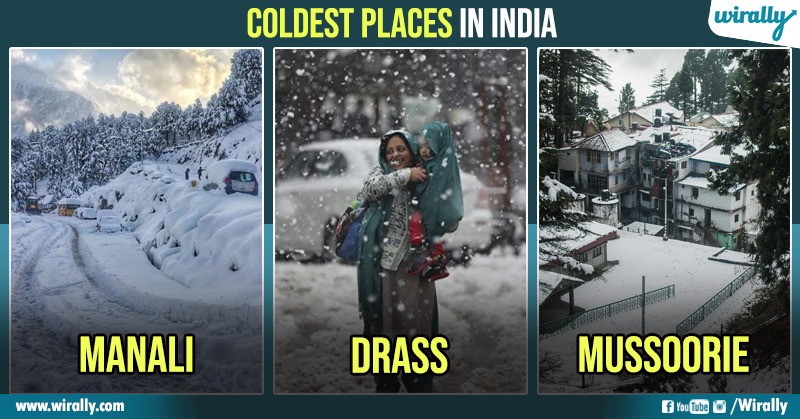Dras To Leh: Top 10 Coldest Places In India
India is a country with a variety of climates and topographies, from burning deserts to tropical rainforests. Some areas, however, are hidden inside bone-chillingly frigid temperatures all year round. For those seeking relief from the heat or simply pining for a winter wonderland, these locations, which are frequently encircled by high mountains and decorated with breathtaking natural beauty, provide a distinctive experience. The top 10 coldest locations in India are examined in this list. These locations demonstrate the immense range and beauty that India has to offer, from the snowy landscapes of Jammu & Kashmir to the calm valleys of Himachal Pradesh and the undiscovered beauty of Arunachal Pradesh.
1. Dras, Jammu and Kashmir:
Dras is the coldest place in India. It has a population of around 1,200 people. The famous food in Dras is Kashmiri cuisine, including Rogan Josh, Yakhni, and Kehwa. The locals primarily rely on agriculture, animal husbandry, and the military. The average temperature in Dras during winter is -20 degrees Celsius. It is often called “The Gateway to Ladakh.” Thasgam Valley is a small village situated on the bank of the Dras River, surrounded by mountains and glaciers. The village is rich in fauna and flora, hosting Himalayan brown bears, ibexes, Himalayan foxes, wolves, junipers, wild tulips, and many more varieties. Dras is one of the best places for trekking, hiking, rafting, and camping.

2. Leh, Jammu and Kashmir:
The city is located on the bank of the Indus River. The mountains dominate the landscape around Leh, as it is at an altitude of 3,500m. Leh has a cold desert climate. The city receives occasional snowfall during winter, which is very cold by Indian standards, mainly due to its high elevation. Buddhism is the largest religion in Leh. It has a population of approximately 30,000 people. Agriculture, tourism, and the military are the main sources of occupation. Famous foods in Leh are Ladakhi cuisine, including Thukpa, Momos, and Butter Tea.
3. Kargil, Jammu and Kashmir:
It is the second-largest city in Ladakh after Leh. Kargil has an average elevation of 2,676 meters. It has a temperate climate, with long and chilly winters, often dropping below −20 °C. Kargil has a population of around 14,000 people. It is located at the confluence of multiple river valleys: the Suru River valley to the north and south, the Wakha Rong valley to the southeast leading to Leh, and the Sod Valley to the east leading to the Indus Valley near Batalik. Kargil is located at a key junction of routes between Kashmir, Ladakh, and Baltistan. The famous foods in Kargil are Balti cuisine, including Skyu, Kargil Apricot Jam, and Phirni. The locals are engaged in farming, trade, and government services.
4. Pahalgam, Jammu and Kashmir:
Pahalgam has a population of approximately 4,600 people. Its lush green meadows and pristine waters attract thousands of tourists from all over the world each year. Pahalgam holds a central position in the Lidder Valley. Tourism-related activities, agriculture, and handicrafts are common occupations. The Amarnath cave, a Hindu shrine, is located in Pahalgam. Pahalgam is one of the most important sites for Hindus. It is believed that Lord Shiva imparted the secret of immortality (Amrit Vachan) to Parvati in Pahalgam. Before entering the Amarnath cave, Lord Shiva left Nandi in Pahalgam. Famous foods here are Kashmiri Wazwan, including Dum Aloo, Gushtaba, and Modur Pulao.
5. Manali, Himachal Pradesh:
Manali has a population of around 8,100 people. It has grown from a trading village to a small town. Tourism, apple farming, and handicrafts are the main sources of occupation. Manali has witnessed a flurry of activity related to hydroelectric power and tourism. Unplanned and rampant construction has led to severe depletion of forests and pollution of river bodies, along with garbage being disposed of on the side of the mountains. Famous foods here are Himachali cuisine, including Dham, Trout Fish, and Siddu. The Kullu Valley in which Manali is situated is often referred to as the “Valley of the Gods.”
6. Gulmarg, Jammu and Kashmir:
Gulmarg lies in a cup-shaped valley in the Pir Panjal Range of the Himalayas, at an altitude of 2,650 m. The natural meadows of Gulmarg, covered with snow in winter, allow the growth of wildflowers such as daisies, forget-me-nots, and buttercups during spring and summer. Gulmarg is the “heartland of winter sports in India” and was rated as Asia’s seventh-best ski destination. Famous foods in Gulmarg are Kashmiri Kahwa, Sheermal, and Wazwan delicacies. Gulmarg has a population of approximately 600 people.
7. Shimla, Himachal Pradesh:
Shimla is the capital and the largest city of Himachal Pradesh. It has a population of around 170,000 people. Major city center attractions include the Shri Hanuman Jakhu (Statue), Jakhu Temple, Viceregal Lodge, Christ Church, Mall Road, The Ridge, and Annandale. The Kalka–Shimla Railway line, built by the British, a UNESCO World Heritage Site, is also a major tourist attraction. The main forests in and around the city are Pine, Deodar, Oak, and Rhododendron. Temperatures typically range from −4 °C (25 °F) to 31 °C (88 °F) over the course of a year. Himachali Siddu, Chha Gosht, and Tudkiya Bhath are famous food items in Shimla.
8. Mussoorie, Uttarakhand:
Mussoorie is a hill station in Uttarakhand. The hill station is in the foothills of the Garhwal Himalayan range. Mussoorie has a population of approximately 30,000 people. Mussoorie has long been known as the “Queen of the Hills.” The economy in Mussoorie is primarily dependent on tourism. Tourism and hospitality are the main sources of livelihood. In recent years, Mussoorie has gained popularity as an upcoming travel destination with many attractions such as Camel’s back road, Dhanaulti, Lal Tibba, etc. The Uttarakhand Government reported 3.02 million (30.23 Lacs) travellers to Mussoorie in 2019. Famous foods here are Garhwali cuisine, including Kafuli, Bal Mithai, and Singodi.
9. Gangtok, Sikkim:
Gangtok is the capital of Sikkim. Gangtok rose to prominence as a popular Buddhist pilgrimage site after the construction of the Enchey Monastery in 1840. It is located in the lower Himalayas at an elevation of 1,650 m. Gangtok has a population of around 100,000 people. Summer and spring seasons are the most popular tourist seasons. Many of Gangtok’s residents are employed directly and indirectly in the tourism industry, with many residents owning and working in hotels and restaurants. Tourism, government services, and agriculture are the primary occupations. Famous foods here are Sikkimese cuisine, including Gundruk, Momos, and Chhurpi.
10. Tawang, Arunachal Pradesh:
Tawang is inhabited by the Monpa people. The average temperature in Tawang is 10.3 °C. Tawang receives snowfall every year during December–January. The notable and worth visiting places here are Sela Pass, Bumla, Lumla, Shonga-tser (Madhuri) Lake, PTSO Lake, and Zemithang. Famous foods in Tawang are Arunachali cuisine, including Thukpa, Zan, and Apong (local beer). Tawang has a population of approximately 49,000 people. Handicrafts are one of the main sources of livelihood.
These places are not only known for their cold temperatures but also for their breathtaking natural beauty. Each location offers unique landscapes, including snow-capped mountains, lush valleys, pristine lakes, and scenic meadows.

